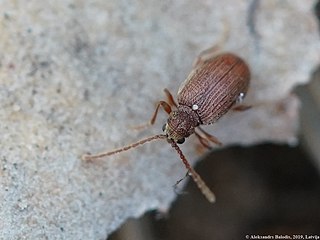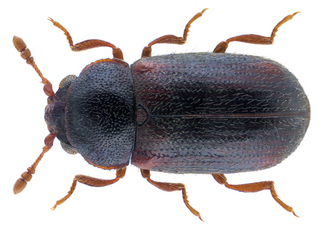
Omorgus is a genus of beetles of the family Trogidae with about 140 species worldwide. Omorgus beetles are generally between 9 and 20 mm long.

Trox is a genus of hide beetle in the subfamily Troginae.

Harpalus is a genus of ground beetle first described by Pierre André Latreille in 1802.

Agonum is a large genus of ground beetles in the subfamily Harpalinae, tribe Platynini. They are mid-sized to smallish beetles, typically with dark metallic hues – often reddish or bronze, but sometimes black, green etc.

Gyrinus is a genus of small aquatic whirligig beetles in the family Gyrinidae native to the Palearctic, the Near East, the Nearctic, North Africa, Asia and Australia.

Ptinus dubius is a species of spider beetle in the family Ptinidae.

Anchomenus is a genus of ground beetle native to the Palearctic, the Near East and North Africa.

Synuchus is a genus in the beetle family Carabidae. There are more than 80 described species in Synuchus.

Platyninae is a subfamily of ground beetles.

Enicmus is a genus of beetles in the family Latridiidae, the minute brown scavenger beetles.

Monotomidae is a family of beetles in the superfamily Cucujoidea. The family is found worldwide, with approximately 240 species in 33 genera. The ecological habits of the family are diverse, with different members of the group being found under tree bark, in decaying vegetation, on flowers and in ant nests. Their ecology is obscure, while at least some species are mycophagous, feeding on the fruiting bodies of ascomycete fungi, Rhyzophagus are predators on bark beetles and possibly Phoridae larvae, with the larvae of some species also being mycophagous.
Aneflomorpha is a genus of beetles in the family Cerambycidae, containing the following species:

Anelaphus is a genus of beetles in the family Cerambycidae, first described by Earle Linsley in 1936.

Trachyderini is a tribe of long-horned beetles in the family Cerambycidae. There are at least 140 genera and 650 described species in Trachyderini.

Crossidius is a genus of beetles in the family Cerambycidae.

Epicauta is a genus of beetles in the blister beetle family, Meloidae. The genus was first scientifically described in 1834 by Pierre François Marie Auguste Dejean. Epicauta is distributed nearly worldwide, with species native to all continents except Australia and Antarctica. Surveys have found the genus to be particularly diverse in northern Arizona in the United States. Few species occur in the Arctic, with none farther north than the southern edge of the Northwest Territories, Canada.

Phyllobaenus is a genus of checkered beetles in the family Cleridae. There are at least 60 described species in Phyllobaenus.

Languria is a genus of lizard beetles in the family Erotylidae. There are about 18 described species in Languria.

Sphindus is a genus of cryptic slime mold beetles in the family Sphindidae. There are at least three described species in Sphindus.
Ozognathus is a genus of death-watch and spider beetles in the family Ptinidae. They are native to the Americas.
















